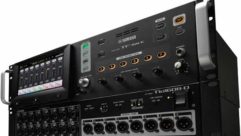
Is Ipod Audio Good Enough?
Ipods and their work-a-likes are the rage among consumers, but there are many professional opinions about whether they are good enough to use as a playback source in sound reinforcement systems. I decided to investigate by testing some personal media players.
Tricky to TestNo Y-Cables, PleaseSome Surprises
Ipods and their work-a-likes are the rage among consumers, but there are many professional opinions about whether they are good enough to use as a playback source in sound reinforcement systems. I decided to investigate by testing some personal media players.
Hardware and file format were the biggest issues in the test. The hardware had to perform well for all major performance criteria — including output level, DC offset, frequency response, phase response, crosstalk, distortion and signal-to-noise ratio — to be taken seriously as a program source for a sound system.
Personal media players are not easy to test because they are playback-only devices. One cannot execute a typical two-port measurement. Fortunately, test equipment manufacturer Audio Precision developed a personal media player test for use with its top-of-the-line analyzers. The routine involves transferring some special multitone audio files to the unit, then playing them back into the Audio Precision analyzer, which determines each of the major performance criteria.
I augmented the Audio Precision tests with a few of my own that would be particular to audio technicians. Signal polarity is important, since the audio tech may want to use the personal media player in conjunction with a polarity test receive device (such as Ivie IE35, Galaxy Cricket, Audio Toolbox). This is done by playing a special pulsed waveform into the sound system, and sampling it with the receive device that shows whether the polarity is normal or inverted. One of the tested players was reverse polarity.
The output (source) impedance also is of interest; proper interface practice is to connect an analog audio source (a low impedance) to a much higher impedance input. I tested this using the voltage divider method, which involves progressively loading the media player with a variable resistance box until its output voltage is half of its open-circuit voltage. This creates a matched interface, which means that the value of the load resistance is equal to the source impedance of the media player. Any analog audio device should never see less that 10 times its source impedance when interfaced into a sound system.
Many audio people are given to inappropriately using Y-cables to sum the left and right channels for mono playback of stereo program material. So I again checked their specifications under this condition.
The tests confirmed what I have been saying for years: Don’t do it. Every device failed the frequency response, distortion and signal-to-noise ratio tests. The very-low output impedance of these devices (less than 6 ohms) keeps them from working well into a matched interface, which is what a Y-cable produces. If you need mono, use one channel only or get a mixer.
Handheld speech intelligibility meters are hitting the audio marketplace. These need a special test waveform to be played over the sound system, which is re-acquired and scored by the handheld analyzer. The test is called STI-PA, or Speech Transmission Index for Public Address systems. The test requires an accurate playback source, and many have felt that the MP3 file format, with its lossy compression algorithm, is unsuitable for this application. Some of the personal media players failed this test, but it wasn’t because of the MP3 file format.
My final test dealt with using personal media players as a sweep track source for acquiring the room’s impulse response. A 14-second, logarithmic sine wave sweep is played over the sound system. A recording of this sweep is made at the desired listener position. Comparing the “dry” sweep with the recorded sweep derives the room’s impulse response. (I have written much about this process in Syn-Aud-Con newsletters over the past few years.) This was the most difficult test for any media player to pass. Many of them proved unsuitable for this use, producing aliases or false frequencies in their output as the sweep approached 20kHz. I had thought that alias issues were in the past for digital audio, but this proved me wrong.
One would expect that a personal media player would need to have WAV file support to pass the tests. WAV files are sample-accurate with no lossy compression schemes to save disk space, and I used this format on media players that support it. I used MP3 format on those that did not. The first device I tested using MP3, the Samsung YP-U2J, failed miserably, which made me highly suspicious of the MP3 format. This turned out to be unfounded, as the Samsung Z5 passed all tests using MP3. One can theorize that lossy compression schemes don’t do much to sine waves. It even proved acceptable for the complex STI-PA noise waveform, with its rigid time and frequency characteristics.
Is Ipod Audio Good Enough?
Ipods and their work-a-likes are the rage among consumers, but there are many professional opinions about whether they are good enough to use as a playback source in sound reinforcement systems. I decided to investigate by testing some personal media players.
The ResultsMic or Line?
Some personal media players are appropriate for sound system testing, some are not. The best ones are the iPod Video and iPod Nano. They passed all tests with flying colors, and even proved to be superior to the on-board computer sound cards that were tested, likely because of the increased isolation from electrical noise from being a standalone device.
A word of caution: The iPod has unacceptable distortion when full-scale sine waves are played at full playback level (about 1Vrms or 0dBV). For optimum results, turn down the unit about 3dB when conducting system tests.
The iPod shuffle did not fare as well, contrary to some marketing claims of it being the optimum iPod for audio. It’s amazingly small and lightweight, but the distortion, noise, and crosstalk specs were not up to par with its larger siblings, probably because of the very compact design. It’s fine for use while jogging or in the weight room, but stick with the Nano or Video for system testing and serious listening.
Most personal media players have full-scale output levels of about 0dBV. This is more than enough to drive the line-level input of a mixer. While the output impedance is low enough to drive the typical microphone input, I would not suggest doing so. While I did not test for it, phantom power could be a problem. A simple stereo 3.5mm-to-1/4-inch cable should be fine for driving the mixer directly with a few meters of cable. If you need to drive a long line or a microphone input, a number of unbalanced-to-balanced interface boxes are available, such as ProCo, Whirlwind, or Jensen.
I am not a big fan of integrating consumer gear into professional systems, but the iPod is a notable exception. The audio performance is up to par for system testing and better than the typical PC sound card. Factor in the convenience of having test waveforms and a music library in your shirt pocket, and it’s hard to not love these devices.
Pat Brown is president of Synergetic Audio Concepts (Syn-Aud-Con) Inc. and Electro-Acoustic Testing Company (ETC) Inc. Syn-Aud-Con conducts training seminars in audio and acoustics worldwide for those who operate, install, and design sound reinforcement systems. ETC performs precision loudspeaker testing for the audio industry. Pat can be reached at [email protected].









